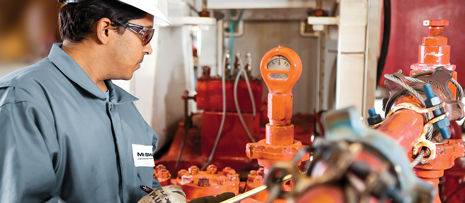|
Despite using MPD, two previous attempts to drill Well 301 in Camaronero field failed to reach total depth (TD). The vertical well targeted the medium Miocene, which is known for its steeply rising formation pressure, narrow drilling window, and inter-bedded loss zones. The conditions cause severe influx from water zones during drilling, as well as loss of circulation.
Steep ramps in pore pressure, combined with loss zones in the field, created a cross-flow of reservoir fluids from one zone to another, that was difficult to control and contributed to well control complications. The drilling window effectively was reduced to less than 0.09 g/cc.
Pemex and Schlumberger teamed up to perform a thorough study of the problem, and find a new approach to address drilling challenges for the sidetrack, to avoid a repeat well failure.
OPERATIONAL CHALLENGES
Narrow margin wells are difficult to drill without MPD. After studying drilling reports from previous attempts to drill a 6⅛-in. hole, the team observed that, despite previously using a different automated MPD system, problems related to a Very Narrow Mud Weight Window (VNMWW) persisted.
The presence of a VNMWW between pore pressure and fracture gradient resulted in drilling fluid losses and influxes that caused continuous well control problems. Inaccurate estimations contributed to formation pressure uncertainties. The team noted that poor decisions were made in a cross-flow scenario, in which procedures were either incorrect or insufficient. The team also observed problems with influx from water zones, and seven well-control events in the original 6⅛-in. hole section.
Combining automated advanced technology with wellsite engineering support, the team’s objectives included increasing the safety of personnel and equipment, using the closed-loop control system; performing a controlled formation pressure test using the MPD choke; reducing fluid losses and well control events, avoiding unnecessary changes in mud density, minimizing non-productive time (NPT) and corresponding operating costs; and achieving oil and gas production by reducing formation damage.
MPD STRATEGY
In addition to controlling the density of the drilling fluid and flowrate, the MPD technique allows annular pressure to be managed by controlling the surface back pressure (SBP). The team’s design strategy for the Well 301 offset included static mud weight of 2.30 g/cc, combined with an automated pressure control system, to keep an equivalent density of 2.42–2.45 g/cc throughout drilling. Connections were adopted to improve the capability for controlling influx and avoiding conventional well control.
By minimizing peak wellhead pressure and surface flowrates, wellbore cycling could be eliminated. Onsite engineering support helped model continuously changing well conditions and ensure that the automated control system was adjusted, as required. By performing controlled formation pressure tests during drilling, the boundaries of the drilling window were constantly measured, which helped to reduce fluid losses and well-control events, and reach planned TD.
The proposed MPD strategy was to drill, using lower mud densities than those in conventional drilling, as well as maintaining the surface back pressure (SBP) while drilling. Additional backpressure would be applied during connections to maintain constant bottomhole pressure (CBHP) and enable Pemex to respond immediately to the slightest mud loss event, because SBP could be reduced immediately to stop losses quickly. Conversely, at the slightest sign of influx, the SBP could be increased to add to bottomhole pressure (BHP) and stop formation fluids from entering the well. The level of automation by the MPD system allowed a quick response to abnormal pressure during drilling.
Wellbore geometry, trajectory, bottomhole assembly (BHA), drillstring components, fluid properties and drilling parameters were used in hydraulics simulations to determine operational window boundaries and surface pressure rates that would meet the design parameters to maintain a CBHP at the selected control depth.
The anchor point for maintaining near-balanced pressure was set to 3,800 m, measured depth (MD), where the formation was most sensitive to influx and loss. The initial, estimated pore pressure identified a high-pressure zone from 3,680 m to 3,800 m, MD. The pressure then drops in a lower pressure zone from 3,800 m to TD at 4,169 m, MD.
To maintain pressure balance at the control depth, surface pressure ranged between 50 and 250 psi, with flowrates adequate to deliver minimum annular velocity of 55 m/min. for hole cleaning. A dynamic leakoff test could also be deployed to confirm the estimated fracture pressure and avoid catastrophic losses. The maximum pore pressure was 2.35 g/cc.
USING OIL-BASE MUD
An oil-base mud (OBM) was selected, so maximum pore pressure could be exceeded as required, and the mud rheology could meet minimum hole cleaning requirements without excessive frictional pressure losses in the annular space. The OBM also minimized formation damage. The fluid used in the 6⅛-in. section with the automated pressure control system had the characteristics shown in Table 1.
| Table 1. Planned drilling fluid properties. |
|

|
The drillstring used for the modeling was tapered, combining 5-in. and 4-in. drill pipe. The BHA configuration had a 4.75-in. diameter with a downhole motor, monel, annular pressure-while-drilling (APWD), and MWD/LWD, heavyweight drill pipe (HWDP), drill collars and jar.
The flow modeling strategy in the planning phase was important to make the initial inputs in the automated pressure control system. The modeling was kept current throughout the drilling process, updating mud parameters and backpressure inputs along hole depth, and validating with pressure-while-drilling measurements as drilling progressed.
The planned operational window set the boundaries, based on the geopressure prognosis and hydraulics limits. The plan was to navigate in the green zone of the window (Fig. 1), maintaining a minimum equivalent circulating density (ECD) of 2.42 g/cc, as a safety margin above the estimated pore pressure of 2.34 g/cc.
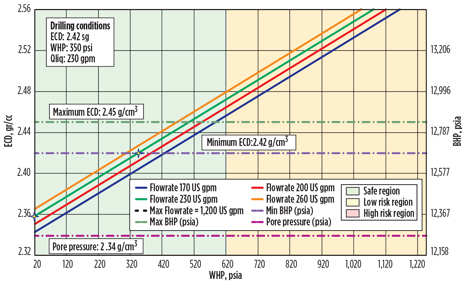 |
| Fig. 1. Planned operating window. |
|
The fully automated, annular pressure control system used the value of 2.42 g/cc as the set point to maintain a constant BHP. Fluid velocity in the annular space between the drill pipe string and the open hole, as well as in the 7⅝-in. liner, exceeded 55 m/min. This velocity is empirically acceptable for good hole cleaning. Although the transition from the 7⅝-in. liner to the 9⅞-in. casing shows annular velocity drops below the recommended minimum value, the team felt the risk could be mitigated with good drilling practices, including viscosity pills and controlled rates of penetration.
Additional design considerations included rheology factors for minimum hole cleaning conditions, bottomhole tool limits (MWD, APWD data transmission), and strategies for connections and bit trips to surface. Hydraulics simulations for drilling, connections and pipe tripping were performed in the configuration design for the automated MPD system. The flow model was calibrated continuously with current drilling data and pressure readings received from the APWD tool in real time. By using a Coriolis flowmeter, the automated MPD system can quickly detect fluid loss or gain events, allowing for response time and reducing the severity of the associated issues.
The dedicated auxiliary backpressure pump helps improve overall pressure stability in the well and is also an additional safeguard against any sudden drop in the rig pump pressure. Automatic MPD reduces or minimizes the risk of conventional operations by avoiding human error.
OPERATING SEQUENCE
A flow chart (Fig. 2) shows the sequence of operations to start drilling the 6⅛-in. hole section for the Camaronero 301 well. The main change between the planned operating window and the final operating window was the reduction in mud weight from 2.30 to 2.28 g/cc when fluid losses began at 3,711 m.
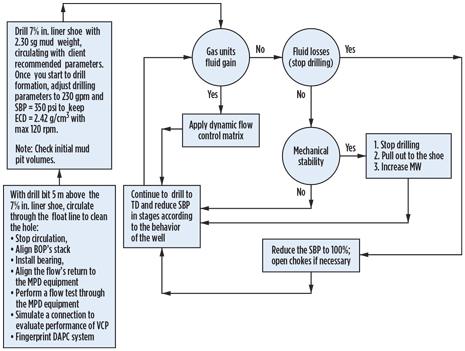 |
| Fig. 2. Managed pressure drilling flow chart. |
|
Another important change included SBP applied with the MPD choke, using values between 40 psi (representing surface friction with chokes 100% open) to 260 psi. ECDs were managed between 2.426 and 2.451 g/cc, prioritized to avoid influxes from possible mud contamination with water and to maintain mechanical stability. Figure 3 shows the final operating window, and Fig. 4 shows the effective ECD vs. pore pressure and fracture gradient along the entire well section.
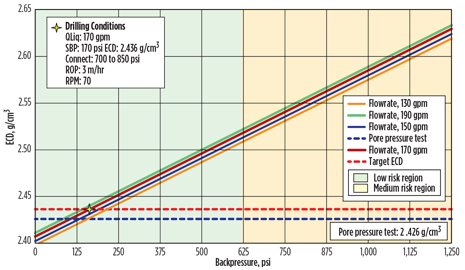 |
| Fig. 3. Final operating window. |
|
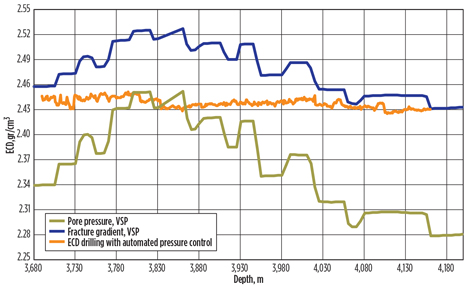 |
| Fig. 4. Applied ECD vs. real formation pressure window. |
|
During drilling, automated MPD functions detected and controlled kicks and ballooning effects, and maintained BHP within the high-pressure tight window between 2.426 and 2.451 g/cc.
RESULTS
From 3,711 m to the end of the drilling section (4,169 m, MD), CBHP was maintained by adjusting the choke opening, delivering the expected results of the automated MPD system. Fluid losses were reduced 40%, compared with the previously drilled section. Although cross-flow environments were handled, a decision to increase the mud weight from 2.28 to 2.30 g/cc to mitigate the expected high-pressure zone caused an increase in the rate of mud losses from existing fractures. Well control events were reduced from seven in previous attempts to two.
The system allowed tripping, while reducing the possibility of losses and influx events. The use of APWD proved to be a valuable tool, especially in narrow operating windows, which enabled safe navigation between pore pressure and fracture gradient. The ECD values were lower than 2.45 g/cc to avoid losing circulation, but greater than 2.436 g/cc to avoid changes from influxes.
The calculation by the automated MPD system and hydraulic simulations were supported equally by the real-time logging tool, giving more confidence to the client with only a slight difference between the calculated and measured data. During drilling operations, the difference between the calculated ECD and PWD tool was only about 0.006 g/cc
The use of an automated MPD system with proper engineering design and teamwork helped Pemex successfully reach the production zone in this part of Camaronero field for the first time. TD was achieved with a cemented liner, which was not previously possible. The coordinated effort to find a fully automated MPD solution enabled PEMEX to avoid an additional well failure, and formulate technologies and methodologies to realize greater successes in a challenging basin. 
ACKNOWLEDGMENT
This article is based on SPE paper 166163, presented at the 2013 SPE Annual Technical Conference and Exhibition, New Orleans, La., Sept. 30-Oct. 2, 2013.
|

